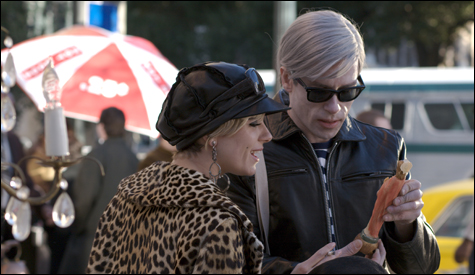
DON’T BLAME SIENNA AND GUY: It’s the writing and the direction that come up short.
|
Who was Edie Sedgwick? Was she a muse who inspired some notable work by Andy Warhol and Bob Dylan or just a footnote in their careers? Did she have any talent or accomplishments of her own? Why, in short, does she deserve a bio-pic?
Alas, Factory Girl answers none of these questions. Despite a committed performance by Sienna Miller, the film’s attempts to explain Sedgwick fall frustratingly short. We learn about her old-money family, her horrific upbringing (marked by family tragedy, institutionalization, and hints of sexual abuse), and her early art-school aspirations. Arriving in New York and hooking up with Warhol, she seems to want only to be famous — and who better than Mr. 15 Minutes to make that happen? Later, she befriends Dylan, though it’s not clear what he sees in her. She falls out of favor with both men, spirals into drug addiction and depravity, and drops out of the scene — at which point the movie loses interest in its own subject.
Factory Girl almost works as an accidental bio-pic about Warhol. The movie re-creates the atmosphere of the Factory, the tin-foiled studio where he cranked out his art and served as ringmaster to a circus of hangers-on. Director George Hickenlooper even emulates the look and feel of a Warhol film, with ennui and outrageousness trying to pass themselves off as excitement and glamor.
The screenplay by Captain Mauzner (Wonderland) doesn’t really get at Warhol’s importance as an artist (or even whether he was any good), but it does dissect his personality and character. Guy Pearce makes the most compelling movie Warhol since Jared Harris in I Shot Andy Warhol, plumbing depths even Harris didn’t reach. Pearce gets at Warhol’s alternating self-confidence and insecurity, his radicalism and ordinariness (he has some wonderful moments in a Catholic confessional and at home with the artist’s Polish mother), his gift for collecting friends and his inability to attach to any of them. This Warhol is also a manipulative cheapskate who nickel-and-dimes his associates and tosses them aside if they’re disloyal or if someone more interesting comes along.
According to the movie, Warhol vied with Dylan for Edie’s soul. (Thanks to legal threats from Dylan, the character is never referred to by name, but Hayden Christensen’s scowling rebel is pretty clearly Dylan, or maybe James Franco.) The film is no more interested in Dylan’s music than in Warhol’s art, only in what he represents: authenticity and emotion. (Dylan claims the affair depicted here never happened; Christensen is no more convincing in this romance than he was by the lake on Naboo, despite what you’ve read about the movie’s undeservedly notorious sex scene.) Although Warhol and Dylan are supposed to be opposites (as is apparent in the film’s best scene, an awkward confrontation at the Factory), they seem a lot alike here, both cryptic and elusive in discussing their work, both vampires who suck up the enthusiasm of others and discard them when they’re finished. The moment when Edie is forced to choose between them is supposed to be the turning point of her life, but they seem equally disastrous.
The film places most of the blame for Edie’s downfall on Warhol’s betrayal of her, though there’s a tacked-on narrative frame in which a scrubbed-clean Edie tells all to her therapist in rehab and admits she has no one to blame but herself. This frame is reported to have replaced a series of talking-head interviews with knowledgeable Ediephiles (like her brother Jonathan and the late George Plimpton); only a couple of these survive, relegated to the closing credits. They describe her vivacious personality in ways that Factory Girl itself fails to, suggesting that Sedgwick really is a fascinating subject deserving of a bio-pic, one that’s yet to be made.